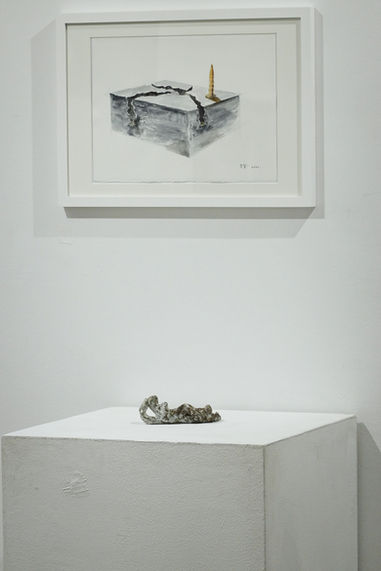Gravity's Rainbow 万有引力之虹
Nie Shiwei 聂世伟 & Wang Lei 王垒
Curated by Alexandra Grimmer
Loft 8 Gallery, Radetzkystr. 4, 1030 Wien
March 8 - March 22, 2024 | Wed - Fri 2 - 6pm, Sat 11am - 3pm
For the exhibition featuring Nie Shiwei and Wang Lei, the title was borrowed from Thomas Pynchon's novel Gravity's Rainbow (1973, Viking Press, USA). The protagonists of this fifth exhibition organised by the BMCA Collection at Loft 8 Galerie Vienna are two artists who both live in Beijing. Their works contain precisely the kind of dense energy and necessity that can be found in this particular city. Since the beginning of China's contemporary art scene in the early 1990s, Beijing has probably been its cultural centre, although regular upheavals, development plans and the proximity to the government complicate the work and associated projects, demanding energy and will from each individual.
Pynchon's books span a wide range of time periods and continents. Their theme can generally be described as the compulsion to make connections and the associated danger of paranoia. Just as vigilantly as the author gathers his arguments and offers his readers foresight, contemporary artists are expected to open up new horizons and an unprecedented perspective for the viewer.
Nie Shiwei's paintings, as well as the ceramic works he has created in recent years, do this in a very special way and with a completely different character to the parallel reality sought in Wang Lei's surreal objects and installations.

Nie Shiwei often finds the starting point for his aesthetic in Italian Baroque painting. His paintings are based on the spatial and dynamic arrangement of the human body, which is embedded in a very special colour scheme. While he places his figures in a strange relationship of tension, it is never clear from their form whether they are in motion or whether this has been frozen into a tense pose. Both the interpretation of the bodies and the colouring characterise his painting and distinguish it from the work of other Chinese contemporaries.
Just as Nie Shiwei's bodies are indecipherable, Pynchon's books have always moved in a haze of mystery, a mystery of which it remains unclear whether it actually corresponds to a decipherable fact.
In Wang Lei's work, it is forms and architecture that the artist, born in 1988, takes out of their usual context and transforms into objects of desire by slightly changing their character or appearance. Just as clay modulated capsules of poppy seed plants are given a silver patina after being cast in aluminium, the forms of ordinary factory buildings are moulded into minimalist sculptures in concrete. In no case does it remain with the respective appearance: the aim for the artist is always the arrangement of the forms in a very special spatial situation. Despite the deliberate use of ornamentation, Wang Lei creates spaces that lack personal character: his installations are empty places that require the viewer's active participation in order to get closer to their feeling and mood.
Just like Pynchon, Wang Lei also plays with a feeling of concentrated absence in his site-specific works, associating them with a mysterious fascination.
Just as the exhibition title, reflecting a Rainbow of Gravity spans an arc across multi-layered interpretations and views and thus represents a balance, the works by Nie Shiwei and Wang Lei suggest a certain stability in their message despite their different techniques and approaches.
Installation Views

























Opening Event










Exhibition Preparation









